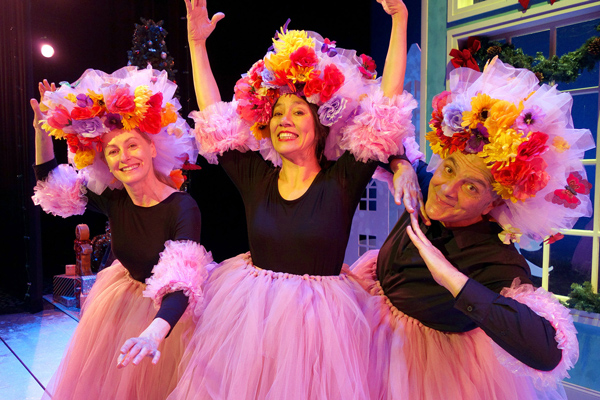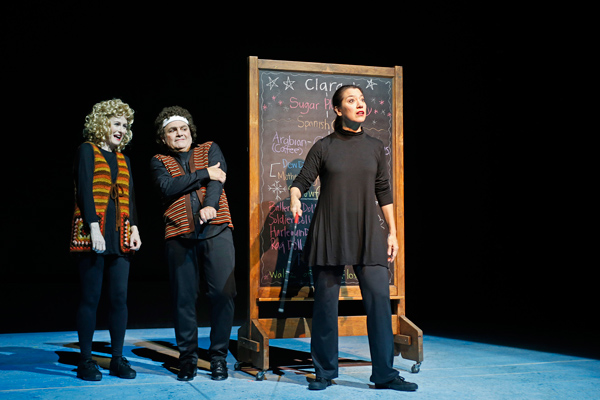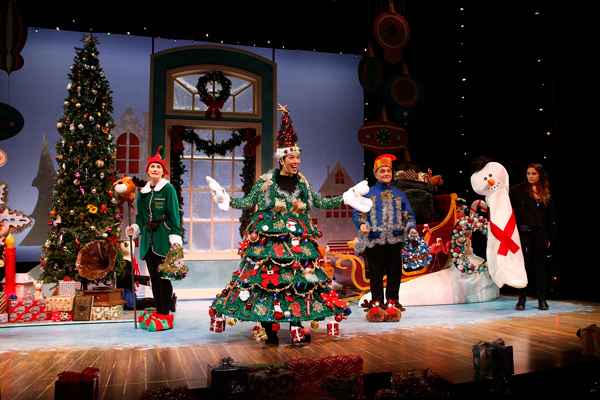If you’re all Nutcrackered out even before Christmas arrives, Sugar Plum Fairy may be the perfect tonic. Sandra Tsing Loh, as actor, writer and comedienne, mines her pre-teen years growing up in the San Fernando Valley. She relates the story of being the younger, nerdy sister of the perfect and steely 15-year-old Kaitlin (performed by Shannon Holt) who got the lead in the Beverly Rosanne School of Dance production of The Nutcracker, and later rejected the part. Meanwhile young Sandra, played by Tsing Loh, was relegated to the chorus to dance to the melody of the Waltz of the Flowers. Or as she asserts in the play—only rejected girls end up in the chorus.

Tony Abatemarco, Shannon Holt and Sandra Tsing. Photo by Debora Robinson/SCR.
While the story of trying out for and performing in The Nutcracker is woven throughout the play, the author/lead actor uses the 75-minute production to bring up a panoply of pre-adolescent yearnings, frustrations, desires and observations, albeit with a variety of sight gags and hilarious costumes. In the opening scene, she wears the funniest costume of all: a stiff, crinoline Christmas-tree dress with presents attached at the bottom and a bewitching sparkly green hat. Donning this outfit, she sings about snow falling and friends calling to the tune of Leroy Anderson’s Sleigh Ride. Then she sardonically asks, “Why do we do Christmas each year like Sisyphus? There are palm trees flocked with artificial snow. We put tinsel on our cacti and reindeers on the beach, make fruitcake that’s gluten-free.”

Shannon Holt and Sandra Tsing Loh. Photo by Debora Robinson/SCR.
Tsing Loh looks back at her childhood and her eccentric friends, played Holt, and by Tony Abatemarco, who also comically and animatedly plays her imperious mother and the ageing Russian superstar ballerina, Madame Irina Lichinska, among other characters. The trio take the audience on a nonstop ride, addressing concerns of Sandra being slighted by her sister and mother, of being coached by her friends to bring out her “inner tiger” during ballet auditions, and later, of dismay about her weight, as she sits alone in her room, devouring a large bag of Fritos, spreading crumbs all over the stage.
Joined then by her two costars, who are also munching chips and dispersing crumbs, Sandra begins to bask in the camaraderie of their friendship. The friends put on ultra-frilly tutus and sway and dance to Tchaikovsky’s Waltz of the Flowers melody. Sandra then expresses joy at being in the chorus, of being in the background with her friends, having fun and not needing to be the star.

Shannon Holt, Tony Abatemarco and Sandra Tsing Loh. Photo by Debora Robinson/SCR.
What began as a Charlie Brown Christmas Special–inspired play, about dealing with depression during the holiday season, according to Tsing Loh in an interview, becomes uncharacteristically syrupy, as the cast and stagehands throw candy and balloons to the audience. They seem to be imparting the message that there is joy in the season—if you’re willing to look for it. But are they really? Or is the frivolity emanating from the stage yet another effort to make fun of the holiday season? Then when Sandra says at the finale, “Theater is for everyone… especially when you’re sitting in a darkened theater at Christmastime, listening to an overture, staring at a red curtain, impatiently waiting for it to lift and reveal a magical fairyland,” she describes Sugar Plum Fairy’s real message. Because in the end, the intent of theater, and of Tsing Loh’s play, is to entertain, beguile, inspire and to hopefully encourage the audience to see a deeper purpose in the angst, challenges and even triumphs of their daily lives.
Sugar Plum Fairy by Sandra Tsing Loh, directed by Bart DeLorenzo at Julianne Argyros Stage, South Coast Repertory, through December 24, 2017.


